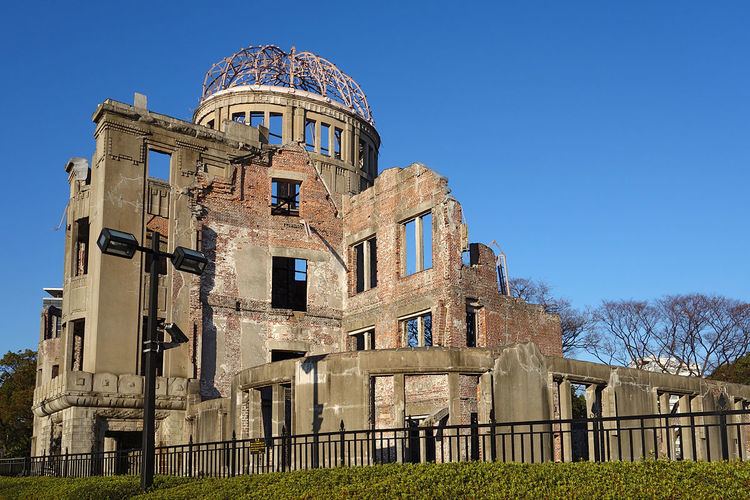Criteria vi UNESCO region Asia-Pacific UNESCO World Heritage Site inscription 1996 | Type Cultural Reference 775 Phone +81 82-242-7831 | |
 | ||
Similar Itsukushima, Itsukushima Shrine, Hiroshima Castle, Children's Peace Monument, Shukkei‑en | ||
Hiroshima peace memorial park letters from japan
'Hiroshima Peace Memorial (広島平和記念碑, Hiroshima heiwa kinenhi), commonly called the Atomic Bomb Dome or Genbaku Dōmu (原爆ドーム?, A-Bomb Dome), in Hiroshima, Japan, is part of the Hiroshima Peace Memorial Park and was designated a UNESCO World Heritage Site in 1996. The ruin serves as a memorial to the people who were killed in the atomic bombing of Hiroshima on August 6 1945. Over 70,000 people were killed instantly, and another 70,000 suffered fatal injuries from the radiation.
Contents
- Hiroshima peace memorial park letters from japan
- Hiroshima peace memorial genbaku dome unesco nhk
- History
- Atomic bombing
- Preservation
- UNESCO World Heritage Site
- References
Hiroshima peace memorial genbaku dome unesco nhk
History
The Product Exhibition Hall building was originally designed by the Czech architect Jan Letzel. The design included a distinctive dome at the highest part of the building. It was completed in April 1915 and was named the Hiroshima Prefectural Commercial Exhibition (HMI). It was formally opened to the public in August that year. In 1921, the name was changed to the Hiroshima Prefectural Products Exhibition Hall, and again, in 1933, to the Hiroshima Prefectural Industrial Promotion Hall. The building was located in the large business district next to the Aioi Bridge and was primarily used for arts and educational exhibitions.
The building was the only structure left standing near the bomb’s hypocenter. Soon commonly called the Genbaku ("A-Bomb") Dome, due to the exposed metal dome framework at its apex, the structure was scheduled to be demolished with the rest of the ruins, but the majority of the building was intact, delaying the demolition plans. The Dome became a subject of controversy, with some locals wanting it torn down, while others wanted to preserve it as a memorial of the bombing and a symbol of peace. Ultimately, when the reconstruction of Hiroshima began, the skeletal remains of the building were preserved.
From 1950 through 1964, the Hiroshima Peace Memorial Park was established around the Dome. The Hiroshima City Council adopted a resolution in 1966 on the permanent preservation of the Genbaku Dome, officially named the Hiroshima Peace Memorial (Genbaku Dome). The Dome continues to be the park’s primary landmark.
Atomic bombing
At 8:15 a.m. on August 6 1945, Little Boy — the first atomic bomb to be used in war — was dropped by the United States Army Air Forces from the Enola Gay, a B-29 bomber. The force of the atomic bomb effectively obliterated the city of Hiroshima, Japan.
On 25 July 1945, General Carl Spaatz, commander of the United States Strategic Air Forces in the Pacific, received orders to deliver a "special bomb" attack on selected cities in Japan. The first target city chosen was Hiroshima, which had an important port on southern Honshu and was headquarters of the Japanese Second General Army with 40,000 military personnel in the city. The bomb was assembled in secret and loaded on the Enola Gay. It consisted of a uranium isotope 235 core shielded by hundreds of kilograms of lead. Little Boy possessed a force equivalent to 12,500 tons of TNT. The plane dropped the bomb over the city at 8:15:17 a.m. local time on August 6 1945. Within 43 seconds of being dropped, the bomb detonated over the city and missed its target by 240 m (790 ft). Intended for the Aioi Bridge, the bomb instead exploded directly over the Shima Hospital, which was very near to the Genbaku Dome. Because the atomic bomb exploded almost directly overhead, the building was able to retain its shape. The building's vertical columns were able to resist the nearly vertical downward force of the blast, and parts of the concrete and brick outer walls remained intact. The center of the blast was displaced 150 m (490 ft) horizontally and 600 m (2,000 ft) vertically from the Dome, having slightly missed the original target, the distinctive "T"-shaped Aioi Bridge. The Dome was 160 meters from the hypocenter of the atomic blast. Everyone inside the building was killed instantly.
Preservation
Weathering and deterioration of the Genbaku Dome continued in the post-war period. The Hiroshima City Council declared in 1966 that it intended to indefinitely preserve the structure, now termed "Genbaku Dome". The first popularly elected mayor of Hiroshima, Shinzo Hamai (1905 – 1968) sought funds for the preservation effort domestically and internationally. During one trip to Tokyo, Hamai resorted to collecting funds directly on the streets of the capital. Preservation work on the Genbaku Dome was completed in 1967. The Genbaku Dome has undergone two minor preservation projects to stabilize the ruin, notably between October 1989 and March 1990.
The Genbaku Dome stands almost exactly as it did after the bombing on August 6 1945. Changes to the ruins, meant to ensure the stability of the structure, have been minimal.
UNESCO World Heritage Site
In December 1996, the Genbaku Dome was registered on the UNESCO World Heritage List based on the Convention for the Protection of the World Cultural and Natural Heritage. Its inclusion into the UNESCO list was based on its survival from a destructive force (atomic bomb), the first use of nuclear weapons on a human population, and its representation as a symbol of peace.
Delegates to the World Heritage Committee from China and the United States had reservations regarding the confirmation of the memorial as a World Heritage Site. China cited the possibility that the monument could be used to downplay the fact that the victim countries of Japan's aggression suffered the greatest losses of life during the war, and the United States stated that having a memorial to a war site would omit the necessary historical context. The United States dissociated itself from the decision.
